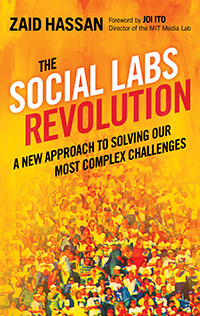
The Social Labs Revolution: A New Approach to Solving Our Most Complex Challenges
Zaid Hassan
181 pages, Berrett-Koehler, 2014
Anyone who has ever suffered under the tyranny of a strategic plan will gain a momentary sense of relief from reading The Social Labs Revolution, by Zaid Hassan. The author delivers relief when he points out how limited such plans are as a way to solve problems. “These planning-based approaches—so common across government, civil society, and even business—represent a neo-Soviet paradigm, one that is spectacularly out of step with what we now know about complexity, about systems, about networks, and about how change happens,” Hassan writes The relief is fleeting, however, because the social lab process that Hassan introduces in his book is as messy and uncertain as the problems that he uses it to address.
Social labs offer an alternative approach not just to planning but also to implementation. The approach, as Hassan describes it, is emerging from work done by scholars and by leaders of several consulting firms. (Hassan is cofounder of Reos, a social innovation consultancy.) It has intellectual and practical roots in fields such as participatory practice, community organizing, developmental evaluation, and design thinking. A social lab approach brings together intentionally diverse teams of stakeholders and gives them time to experiment and to iterate solutions. It also deliberately makes experts uncomfortable. In recounting the work of one lab, Hassan offers this anecdote: “One senior EU advisor, on being told that she had to ‘suspend judgment,’ asked in disbelief, ‘For thirty years, I’ve been paid to exercise my judgment, and you want me to stop?’”
The groups that constitute each lab come together not around a project but around a shared problem. They work through a facilitated process of discovery in which they identify points of agreement and areas of potential intervention. The process then relies on rapid experimentation and external feedback—practices that blur the line between planning and implementation in a useful way. The goal is to try things out at a scale that’s large enough to produce informative results, but not so grand that the risks of implementation become too large for stakeholders to bear.
Hassan draws on several examples to illustrate the iterative nature of the social lab process. The Sustainable Food Lab, for example, is a multi-year effort to find ways to provide healthy, safe food for an ever-expanding global human population. Hassan tells the story, warts and all, of the lab’s efforts to try out various sustainable solutions, including fisheries, smallholder farms, and responsibly grown commodities. He shows that participants struggled to find points of agreement with their peers, and that they were unprepared to make positive use of external critique. (It’s clear that the external stakeholders in this case hadn’t been trained to offer constructive criticism; rather, they were primed to tear down ideas.) At the same time, he uses this story to illustrate what social labs can produce.
Central to the social lab model is the idea that experimentation is different from a pilot program. That might seem like just a substitution of one kind of jargon for another. But Hassan’s analysis of initiatives like the Sustainable Food Lab makes that idea real. Along the way, Hassan highlights several core principles of this model: the need for diversity among stakeholders, the value of using conflict productively, and the benefit of having the freedom—and the funding—to experiment and to make mistakes.
The idea of applying messy solutions to messy problems has an agreeable symmetry. Our shared social problems involve a multiplicity of actors, forces, institutional agendas, and status-quo interests that will work against change at all cost. Making progress is bound to be messy. Failure will happen. Steps forward won’t occur without a few steps backward as well. Hassan lays out these challenges with commendable honesty. The Social Labs Revolution is a refreshing, well-written call to arms for matching knotty problems with less-than neat processes, and for confronting complex issues with complex thinking.
Hassan notes that the social lab model is still under development—that the approach itself is emergent and iterative. (The title of his last chapter is “Next-Generation Social Labs.”) After a decade or so of developing this approach, he and his colleagues can point to successes large and small. They’re also actively involved in learning from their failures and in improving the social lab process.
Much of Hassan’s social lab experience, and several of his examples, relate to work that he did for a consulting firm called Generon. I got a very clear sense that the methods of Generon—its U-shaped process, for example—were not available for public sharing. Hassan’s descriptions of those methods are more obtuse than they need to be. That vagueness is the least helpful aspect of this otherwise promising book. Having convincingly shown that there’s a better way to work toward shared solutions, Hassan doesn’t provide enough detail to help readers figure out how to follow that path. Those who look to this book for a turnkey alternative to strategic planning will find their hopes raised and then dashed. They will be more certain than ever that linear planning doesn’t work, but they won’t come away with the tools needed to apply a social lab method.
Read an excerpt from the book.

